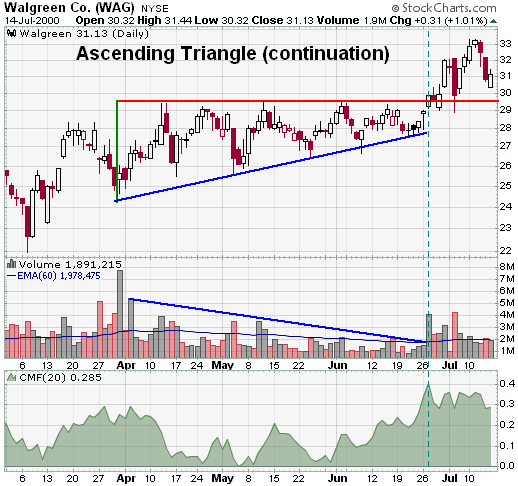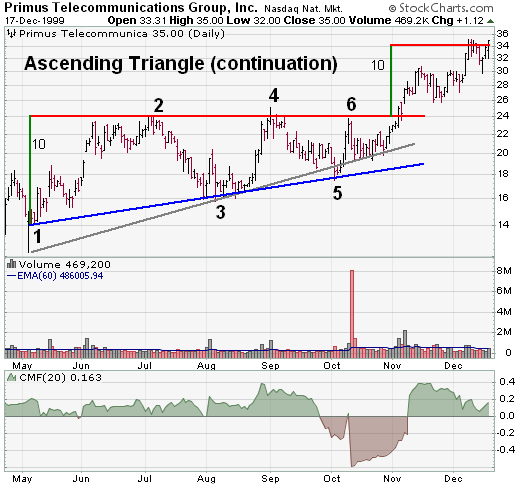The ascending triangle is a bullish formation that usually forms during an uptrend as a continuation pattern. There are instances when ascending triangles form as reversal patterns at the end of a downtrend, but they are typically continuation patterns. Regardless of where they form, ascending triangles are bullish patterns that indicate accumulation.

Because of its shape, the pattern can also be referred to as a right-angle triangle. Two or more equal highs form a horizontal line at the top. Two or more rising troughs form an ascending trend line that converges on the horizontal line as it rises. If both lines were extended right, the ascending trend line could act as the hypotenuse of a right triangle. If a perpendicular line were drawn extending down from the left end of the horizontal line, a right triangle would form. Let’s examine each individual part of the pattern and then look at an example.
- Trend. In order to qualify as a continuation pattern, an established trend should exist. However, because the ascending triangle is a bullish pattern, the length and duration of the current trend is not as important as the robustness of the formation, which is paramount.
- Top Horizontal Line. At least 2 reaction highs are required to form the top horizontal line. The highs do not have to be exact, but they should be within reasonable proximity of each other. There should be some distance between the highs and a reaction low between them.
- Lower Ascending Trend Line. At least two reaction lows are required to form the lower ascending trend line. These reaction lows should be successively higher, and there should be some distance between the lows. If a more recent reaction low is equal to or less than the previous reaction low, then the ascending triangle is not valid.
- Duration. The pattern length can range from a few weeks to many months, with the average pattern lasting from 1-3 months.
- Volume. As the pattern develops, volume usually contracts. When the upside breakout occurs, there should be an expansion of volume to confirm the breakout. While volume confirmation is preferred, it is not always necessary.
- Return to Breakout. A basic tenet of technical analysis is that resistance turns into support and vice versa. When the horizontal resistance line of the ascending triangle is broken, it turns into support. Sometimes there will be a return to this support level before the move begins in earnest.
- Target. Once the breakout has occurred, the price projection is found by measuring the widest distance of the pattern and applying it to the resistance breakout.
Is an Ascending Triangle Bullish?
In contrast to the symmetrical triangle, an ascending triangle has a definitive bullish bias before the actual breakout. If you will recall, the symmetrical triangle is a neutral formation that relies on the impending breakout to dictate the direction of the next move.
On the ascending triangle, the horizontal line represents overhead supply that prevents the security from moving past a certain level. It’s as if a large sell order has been placed at this level, and it’s taking several weeks or months to execute, thus preventing the price from rising further. Even though the price cannot rise past this level, the reaction lows continue to rise. It’s these higher lows that indicate increased buying pressure and give the ascending triangle its bullish bias.

Primus Telecom (PRTL) formed an ascending triangle over six-months before breaking resistance with an expansion of volume.
- From a low of 8.88 in April, the stock established an uptrend by forming a higher low at 8.94 and advancing to a new reaction high in early June. (The beginning of the trend is not included on this chart.) After recording its highest price in 10 months, the stock met resistance at 24.
- In June, the stock hit resistance at 23 several times and then again at 24 in July. The stock bounced off 24 at least three times in 5 months to form the horizontal resistance line. It was as if portions of a large block were being sold each time the stock neared 24.
- The reaction lows were progressively higher and formed an ascending trend line. The first low, in May 1999, occurred with a large spike down to 12.25, but the trend line was drawn to connect the prices grouped around 14. The ascending trend line could have been drawn to start at 12.25, and this version is shown with the gray trend line. The important thing is that there are at least two distinct reaction lows that are consecutively higher.
- The duration of the pattern is around six months, which may seem a bit long. However, all the key ingredients for a robust pattern were in place.
- Volume declined from late June until early October. There was a huge expansion when the stock fell from 23.44 (point 6) to 19.38 on two heavy trading days in October. However, this was only for two days, and the stock found support around 20 to form a higher low. In keeping with the ideal pattern, the next expansion of volume occurred in early November when the stock broke resistance at 24. The stock traded at above average volume 7 of the 10 days surrounding the breakout, and all 7 were up days. Chaikin Money Flow dragged a bit from the two heavy down days, but recovered to +20% five days after the breakout.
- The stock advanced to 30.75 before pulling back to around 26. Support was found above the original resistance breakout, and this indicated underlying strength in the stock.
- The initial advance was projected to be 10 (24 -14 = 10) points from the breakout at 24, making a target of 34. This target was reached within 2 months, but the stock didn’t slow down until reaching 50 in March (not shown). Targets are only meant to be used as guidelines, and other aspects of technical analysis should also be employed for deciding when to sell.
Source: StockCharts
(Only the headline and picture of this report may have been reworked by the ShareMantras staff; the rest of the content is auto-generated from a syndicated feed.)